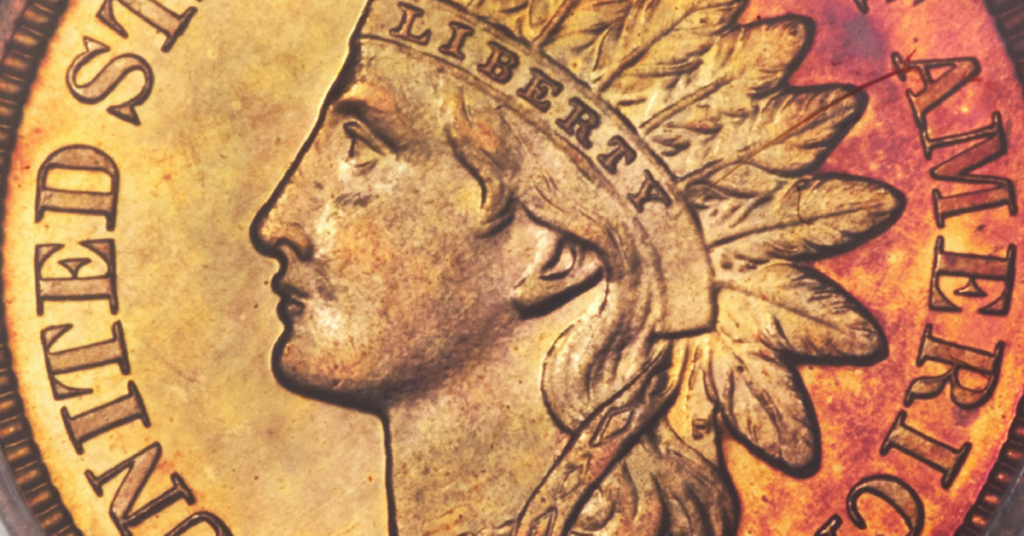What Native Americans Have Been on US Coins?
The historical tribes that make up Native American culture have often been given a place of honor on many of the US Mint’s most popular and enduring coin designs. From the Indian Cents and $3 Gold Pieces of the 1850s to the modern Gold Buffalo Bullion series that began in 2008, Native Americans have been prominently featured in the pantheon of US coinage on many occasions over the past 150 years.
1866 Gold Three Dollar, MS63 | Rarely Seen This Well-Preserved
Buy, Value or Appraise Your US Coins
Bid or buy US coins for sale, value your item, or request a free appraisal to sell your collection.
The story of the Indian Cent in particular makes an excellent study for the later use of this lasting motif in American coinage, honoring the United States’ Native American heritage. James B. Longacre, the Chief Engraver of the US Mint from the 1840s until his passing in 1869, designed the Indian Cent and its many preliminary possible designs, or “patterns.” As with other American coins designed during this time period, there was great symbolic meaning to each aspect of the Indian Cent’s design.
1903 Indian Cent | Finest-Certified PR68 Red
For example, Longacre discussed his choice to use the Native American motif rather than the popular Liberty Cap design when he wrote regarding his use of a feathered headdress on the Indian Cent, “From the copper shores of Lake Superior, to the silver mountains of Potosi from the Ojibwa to the Aramanian, the feathered tiara is as characteristic of the primitive races of our hemisphere, as the turban is of the Asiatic. Nor is there anything in its decorative character, repulsive to the association of Liberty … It is more appropriate than the Phrygian cap, the emblem rather of the emancipated slave, than of the independent freeman, of those who are able to say ‘we were never in bondage to any man’. I regard then this emblem of America as a proper and well defined portion of our national inheritance; and having now the opportunity of consecrating it as a memorial of Liberty, ‘our Liberty’, American Liberty; why not use it? One more graceful can scarcely be devised. We have only to determine that it shall be appropriate, and all the world outside of us cannot wrest it from us.” Clearly, great care and patriotic concern went into producing this design, which is still popular with many collectors today.
A similar theme was later echoed in James Earle Fraser’s Buffalo Nickel design, showing a Native American chief on the obverse and a buffalo on the reverse, as well as the $5 and $10 Indian gold coins of 1907 to 1932, designed by the famous Augustus Saint Gaudens. The Buffalo Nickel proved to be so popular among collectors, in fact, that this design was retooled and resurrected for a recent series of gold bullion coins, the American Buffalo gold bullion series, as well as a 2001 one-ounce silver buffalo coin.
Buffalo Nickel | 1913 5C Type One MS67+ PCGS. CAC
Yet more instances of Native Americans on US coinage can be found when one looks at commemorative pieces. The Arkansas Centennial half dollars of 1935 to 1939, the Daniel Boone half dollar of 1934 to 1938, the Long Island half dollar of 1936, the Missouri half dollar of 1921, the 1936 Providence half dollar, and the Oregon Trail half dollars of 1926 to 1939 all include Indian imagery. Many of these coins reflect Native Americans’ unique role in shaping U.S. history. Later on, two modern commemoratives reflected this theme as well, with the Jamestown silver dollar and gold half eagles of 2007 showing Native Americans as one of the groups that helped to build early America.
Buffalo Nickel | 1913 5C Type One MS67+ PCGS. CAC
2000-P Sacagawea Dollar, SP68 | Glenna Goodacre Presentation
2015-W $1 Mohawk Ironworkers, Enhanced Finish, Early Release, SP69 NGC.
All in all, many different coins, both circulating and commemorative, have highlighted the role of Native Americans in American culture over the years. The focus on these original inhabitants of what is today the United States of America has now reached a level of cultural sensitivity that many would likely welcome, as the US Mint states that today’s Sacagawea Dollars “honor and recognize of the important contributions made by Indian tribes and individual Native Americans.” These coins feature rotating new reverse designs each year that are chosen in conjunction with the U.S. Senate Committee on Indian Affairs, the Congressional Native American Caucus of the U.S. House of Representatives, and the Commission of Fine Arts and the National Congress of American Indians. To see many interesting examples of Native Americans and how they have shaped US numismatics, visit www.ha.com/coins to browse many fascinating pieces.
